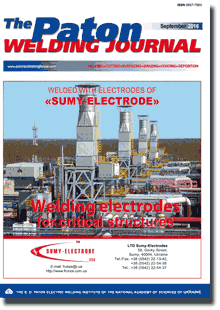| 2016 №09 (12) |
DOI of Article 10.15407/tpwj2016.09.01 |
2016 №09 (02) |

The Paton Welding Journal, 2016, #9, 2-8 pages
Brittle fracture resistance of haz metal in arc-welded joints of high-strength steels with carbon content of 0.55–0.65 %
A.A. Gajvoronsky, V.D. Poznyakov, L.I. Markashova, E.N. Berdnikova and V.Ya. Yashchuk
E.O. Paton Electric Welding Institute, NASU 11 Kazimir Malevich Str., 03680, Kiev, Ukraine. E-mail: office@paton.kiev.ua
Abstract
Modeling methods were used to study the influence of structural-phase composition and diffusible hydrogen on brittle fracture resistance of HAZ metal of high-strength steel with carbon content of 0.55–0.65 %. It is shown that to achieve comparatively high resistance of the joints to crack propagation, it is necessary to ensure formation in the HAZ metal of bainitic-martensitic structure, in which upper bainite is absent, and martensite volume fraction does not exceed lower bainite fraction. At saturation of HAZ metal with hydrogen, which diffuses from deposited metal during arc welding or surfacing, its brittle fracture susceptibility increases markedly. To reduce metal embrittlement, it is necessary to apply special welding techniques, at which hydrogen saturation is minimum (less than 0.2 ml/100 g), or special technological methods, allowing improvement of ductile properties of HAZ metal. 14 Ref., 1 Table, 10 Figures.
Keywords: high-strength carbon steel, arc welding, HAZ, structure, diffusible hydrogen, brittle fracture, fracture surface
Received: 06.04.16
Published: 09.10.16
References
- Shorshorov, M.Kh. (1965) Metals science of welding of steel and titanium alloys. Moscow: Nauka.
- Grabin, V.F., Denisenko, A.V. (1978) Metals science of welding of low- and medium-alloy steels. Kiev: Naukova Dumka.
- Kasatkin, O.G. (1994) Peculiarities of hydrogen embrittlement of high-strength steels in welding. Svarka, 1, 3–7.
- Ignatenko, A.V., Pokhodnya, I.K., Paltsevich, A.P. et al. (2012) Dislocation model of hydrogen-enhanced localizing of plasticity in metals with bcc lattice. The Paton Welding J., 3, 15–19.
- Gajvoronsky, A.A. (2013) Influence of diffusible hydrogen on delayed cracking resistance of high-carbon steel welded joints. Ibid., 5, 14–20.
- Sarzhevsky, V.A., Gajvoronsky, A.A., Gordonny, V.G. et al. (1996) Influence of technological factors on structure and properties of HAZ metal in repair-restoration surfacing of all-rolled wheel flanges. Svarka, 3, 22–27, 33.
- Gajvoronsky, A.A., Poznyakov, V.D., Markashova, L.I. et al. (2012) Influence of deposited metal composition on structure and mechanical properties of reconditioned railway wheels. The Paton Welding J., 8, 16–22.
- (1972) New methods for evaluation of resistance of metals to brittle fracture. Ed. by Yu.N. Robotnov. Moscow: Mir.
- Shorshorov, M.Kh., Chernyshova, T.A., Krasovsky, A.I. (1972) Weldability testing of metals. Moscow: Metallurgiya.
- GOST 25.506: Methods of mechanical tests of metals. Characterization of crack resistance (fracture toughness) in static loading.
- Makhnenko, V.I., Korolyova, T.V., Lavrinets, I.G. (2002) Effect of microstructural transformations on redistribution of hydrogen in fusion welding of structural steels. The Paton Welding J., 2, 6–13.
- Ostash, O.P., Andreiko, I.M., Kulyk, V.V. et al. (2009) Influence of the mode of thermal treatment and load ratio on the cyclic crack-growth resistance of wheel steels. Materials Sci., 45(2), 211–219. https://doi.org/10.1007/s11003-009-9177-4
- Gajvoronsky, A.A., Zhukov, V.V., Vasiliev, V.G. et al. (2014) Structural changes in overheating zone of haz metal of railway wheels in arc surfacing. The Paton Welding J., 1, 13–19. https://doi.org/10.15407/tpwj2014.01.02
- Gajvoronsky, A.A., Zhukov, V.V., Shishkevich, A.S. (2014) Weldability of high-strength carbon steel 65G. Svarka i Diagnostika, 5, 50–54.
Suggested Citation
A.A. Gajvoronsky, V.D. Poznyakov, L.I. Markashova, E.N. Berdnikova and V.Ya. Yashchuk (2016) Brittle fracture resistance of haz metal in arc-welded joints of high-strength steels with carbon content of 0.55–0.65 %. The Paton Welding J., 09, 2-8.The cost of subscription/purchase order journals or individual articles
| Journal/Currency | Annual Set | 1 issue printed |
1 issue |
one article |
| TPWJ/USD | 384 $ | 32 $ | 26 $ | 13 $ |
| TPWJ/EUR | 348 € | 29 € | 24 € | 12 € |
| TPWJ/UAH | 7200 UAH | 600 UAH | 600 UAH | 280 UAH |
| AS/UAH | 1800 UAH | 300 UAH | 300 UAH | 150 UAH |
| AS/USD | 192 $ | 32 $ | 26 $ | 13 $ |
| AS/EUR | 180 € | 30 € | 25 € | 12 € |
| SEM/UAH | 1200 UAH | 300 UAH | 300 UAH | 150 UAH |
| SEM/USD | 128 $ | 32 $ | 26 $ | 13 $ |
| SEM/EUR | 120 € | 30 € | 25 € | 12 € |
| TDNK/UAH | 1200 UAH | 300 UAH | 300 UAH | 150 UAH |
| TDNK/USD | 128 $ | 32 $ | 26 $ | 13 $ |
| TDNK/EUR | 120 € | 30 € | 25 € | 15 € |
AS = «Automatic Welding» - 6 issues per year;
TPWJ = «PATON WELDING JOURNAL» - 12 issues per year;
SEM = «Electrometallurgy Today» - 4 issues per year;
TDNK = «Technical Diagnostics and Non-Destructive Testing» - 4 issues per year.


